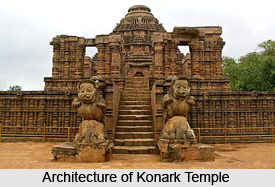 The magnificent ruins on the sandy sea-shore at Konark, at a distance of about twenty miles from Puri, represent the celebrated Konark Temple or Black Pagoda of Orissa, which used to receive the first rays of the sun, rising over the boundless expanse of the Bay of Bengal, to warn the mariners of the danger which the surf still offers to navigation along the coast.
The magnificent ruins on the sandy sea-shore at Konark, at a distance of about twenty miles from Puri, represent the celebrated Konark Temple or Black Pagoda of Orissa, which used to receive the first rays of the sun, rising over the boundless expanse of the Bay of Bengal, to warn the mariners of the danger which the surf still offers to navigation along the coast.
A temple in Orissa consists of (1) the deul or the holy of holies, (2) the Jagamohana or the porch, (3) the Natamandira or the dancing-hall and (4) the Bhogamandira or the hall of offerings. Of these four parts, the Natamandira does not appear to have ever been attached to the Black Pagoda. But presently what remains is a still porch.
The Konark Sun Temple was originally surrounded by a walled enclosure measuring 750 feet by 500 feet. The Jagamohana or the porch, which is still visible in a fair state of preservation, owing to the recent work of "restoration," will amply repay the trouble of visiting the place. It stands on a foundation 66 feet square, with a total height of 100 feet. It consists of vertical walls which, at a height of 60 feet, terminate in a pyramidal roof, with a slope of 72 feet. The friezes in the projecting cornice, arranged in three tiers, in the sloping roof alone, present about 3000 feet of carving, with an astonishing variety of sculpture, portraying almost every aspect of Indian life-pastoral, domestic, civil and military.
The temple was constructed in the form of a chariot. The chariot is drawn by 24 wheels and seven horses. Each wheel of the chariot is 10 feet in diameter. The spokes of the wheel represents the sundials. It is said that wheels represent 24 hours of the day and some says that the wheels represent the 12 month concepts of the year.
Two lions guard the entrance of the temple indulged in an act of striking the elephants. A flight of steps lead to the main entrance. The entire structure of the temple is filled with intricate carvings, sculpture and wonderful images.
The material which has been used for building the Konark Temple is mainly basalt. Immense sized blocks of stone and the huge beams of Iron have been used in the construction of the temple. The sculptures in high relief bear witness to an age when Hindu artists worked form nature. The nymphs are beautifully shaped women, in luscious attitudes; the elephants move along at the true elephant trot, and kneel down in stone as they did in life.
It can be concluded saying the fact that Indians had a keen eye for beauty and details for beauty and perfection. This is undoubtedly visible at Konark, where the effect of the Sun temple was due largely to the contrast between the boundless expanses.





















